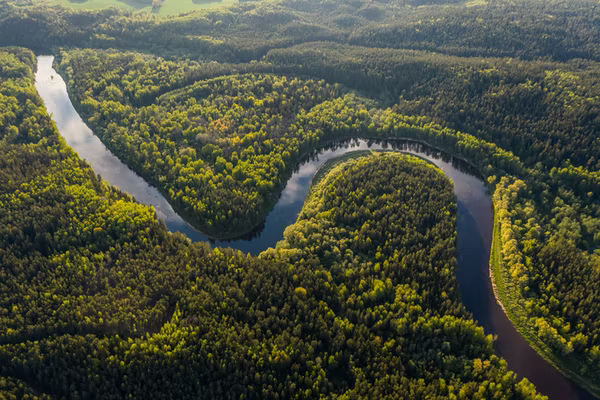As human activity in the Brazilian Amazon increases, the future of
the rainforest has never been more uncertain.
Brazil is once again in the spotlight for hitting an all-time high
in the deforestation of the Amazon.
According to data from the Brazilian space research agency Inpe,
deforestation in the Brazilian Amazon increased by 64% from a year ago, to 941
square kilometres (363 square miles). The area, which is larger than New
York City, has experienced the greatest loss of forest cover since the data
series began in 2015-16.
The Amazon rainforest: nature’s friend no more?
With a surface area of 6,000,000 square kilometres (2,316,612.95
square miles), the Amazon is the largest rainforest in the world. The
rainforest, 60% of which falls in Brazil, represents over half of the planet’s
rainforests.
But the once-mighty rainforest is no longer so. Wildfires,
droughts, and rising temperatures, to name a few, are pushing it past its
breaking point.
Also read: Antarctica hits record 30 degrees Celsius: Experts
Thousands of fires are raging over the Southern Amazon, destroying
one of the world’s most important carbon sinks. According to a study published
in the journal Nature, the former carbon storehouse now produces three times
more carbon dioxide than the remaining vegetation can absorb. Even worse, most of the
rainforest is now completely dry. Widening droughts are hitting Central and
Southern Brazil which means that fires are more likely to escape and spread.
Scientists are more concerned than ever about the Amazon. Some
experts have predicted that the forest will soon hit a tipping point due to the
warmer climate, increasing deforestation, and intense fires, with much of it
becoming barren scrubland. Others, on the other hand, claim that there is
insufficient information to make exact predictions about how long the
rainforest will remain healthy.
Jair Bolsonaro: Where does Captain Chainsaw’s government stand

Whether it’s for his role as an apologist for military
dictatorship, his misogynistic views on women and the LGBTQ community, his
highly conservative views on social matters, or his advocacy of crony
capitalism, Jair Bolsonaro has been the subject of controversy since taking
office in 2018. Matters are no different when it comes to the Amazon.
Let there be no delusion. The rainforest had fallen prey to the
whims of humans decades ago, in the 1900s. But its active downfall began only
in 2018, with the rise of the Bolsonaro regime. Between 2004 and 2012,
satellite monitoring, workers on the ground, legislation to punish offenders,
and the demarcation of indigenous territory and conservation areas were some of
the mechanisms that helped reduce deforestation. With Bolsonaro coming to
power, these have been dismantled systemically. As evidenced by his
environmental policies, the far-right leader is more interested in appeasing
the big farming lobby that harnesses global markets and rewards excessive
consumerism.
Environmentalists and the international community have also
chastised Bolsonaro for reducing funds for rainforest protection programmes and
attempting to open protected territories to agribusiness and mining.
According to reports, Bolsonaro is responsible for the devastation
of approximately 10,000 square kilometres of Brazilian rainforest.
The Bolsonaro administration shifted the tone of its public
remarks in 2021 after two years of downplaying the Amazon problem and ignoring
calls for action. At Joe Biden‘s climate summit in April, Brazil promised to
halt illicit deforestation by 2030. It also committed to quadruple the money
for maintaining the forest’s protection frameworks and pushed the deadline for
becoming carbon neutral from 2060 to 2050. However, the ‘commitments’ have not
been formalized in law or policy. There are also no policies outlining
intermediate and short-term objectives that would allow Brazil to achieve that
goal. In fact, according to the most recent estimates, its emissions have
substantially increased, particularly during the pandemic.
Also read: US missed its climate targets as greenhouse emissions rose in 2021: Report
Not only that, as one might expect from the crafty Bolsonaro
administration, Brazil’s environment minister, Ricardo Salles, reportedly
revealed a previously hidden agenda and tweaked the agreement in backdoor
negotiations with the US and other countries, asking them to pay $1 billion per
year to Brazil in exchange for a 40% reduction in deforestation.
The Climate Change scenario
The reports on Amazon’s newly established deforestation rate comes
only a few months before the UNFCCC’s 27th Conference of the Parties (COP 27) is
set to take place in November of this year.
Until 2019, Brazil received tens of millions of dollars each year
from the donor-backed Amazon Fund to help protect and sustainably use its
forests, but that funding was halted as deforestation only increased during
Bolsonaro’s administration.
In 2020, Brazil’s emissions were greater than in any year
since 2006. According to an analysis by the Greenhouse Gas Emissions Estimates
System (SEEG), land use change activities, such as converting forests to
agriculture fields or cattle pasture, accounted for 46 percent of Brazil’s
emissions in 2020. 90 percent of emissions from land use change came from
deforestation in the Amazon rainforest and the Cerrado wooded savannah.
Agriculture and cattle raising are the main drivers of deforestation in the country,
even as the government “implemented” a plan to reduce pollution from the
sector.
In fact, while most countries produced less carbon emissions amid
the economic crisis brought on by the coronavirus epidemic, Brazil emitted 2.16
billion tonnes of carbon dioxide equivalent in 2020, up from 1.97
billion in 2019.
Also read: File of shame: United Nations slams world leaders for broken climate promises
The Paris Agreement‘s goal of limiting global temperature rise
below 1.5 degrees Celsius becomes increasingly impossible with each square mile
of the Amazon rainforest cut down. And if Brazil maintains its current pace and
performance in the Amazon deforestation, it will undoubtedly be ‘promoted’ from
5th to largest carbon dioxide emitter.







